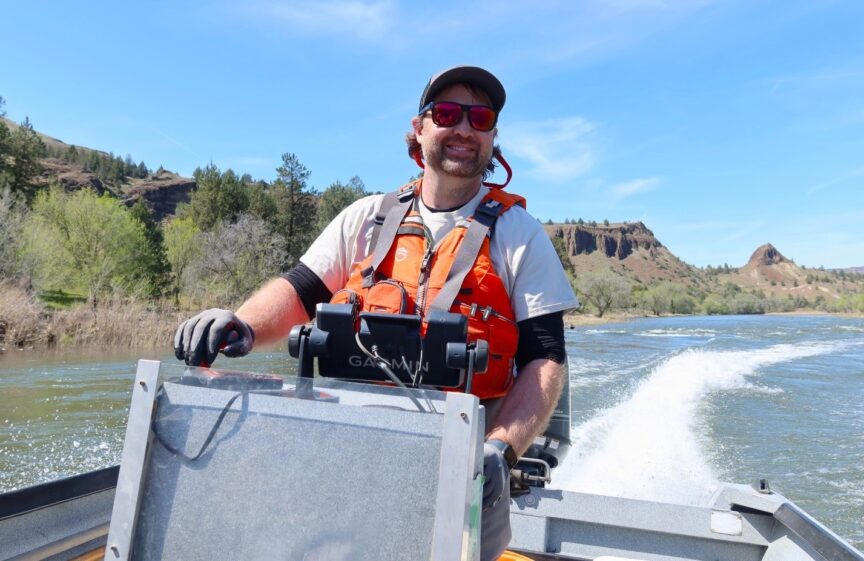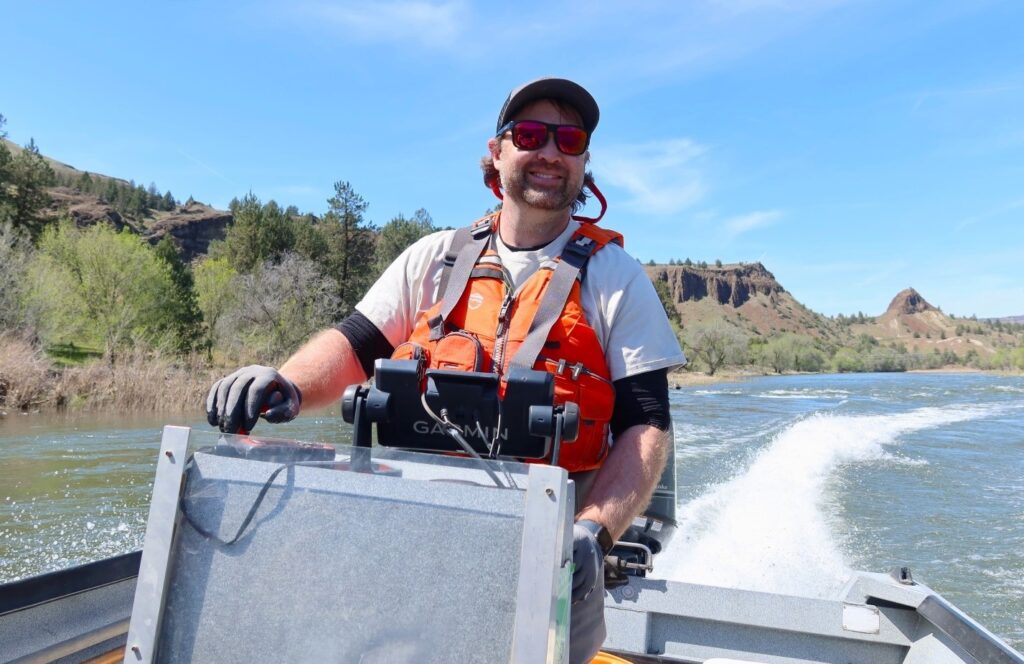
TU’s Oregon Policy Director spends a day with Oregon Department of Fish & Wildlife
Oregon Department of Fish & Wildlife’s fish research and monitoring programs play a key role in supporting recreational fisheries and informing smart investments of restoration funding. Last month, Wild Steelheaders United had an opportunity to ride along for a day of spring Chinook salmon monitoring on the John Day River. The crew caught and tagged juvenile fish en route to the ocean, and the experience drives home the importance of continued funding for this essential yet often unseen work.
AN ORIENTATION TO THE JOHN DAY BASIN
The John Day River in north central Oregon is a remarkable watershed. It’s the longest river flowing entirely within Oregon, the longest undammed river in Oregon, and the third-longest undammed river in the continental U.S. It flows approximately 280 miles from the Malheur and Umatilla National Forests northwest into the Columbia River. (Fun fact: there’s a second, much smaller John Day River in Oregon, near the mouth of the Columbia River.)
Many readers of this blog likely know the John Day as a world-famous wild summer steelhead fishery. Indeed, in years that the stream is open to steelhead fishing, anglers pursue steelhead in the river from around early October well into winter. Steelhead passing through the lower river in autumn migrate well into the Blue Mountains and Strawberry Range, with some fish spawning in the mountainous country above 4,000 feet in elevation.
(To learn more about summer steelhead issues in the John Day, see this article on the topic of adult steelhead “overshooting” the John Day River mouth and this video of Ian Tattam explaining migration patterns of John Day adult steelhead.)
Lesser known amongst anglers are the basin’s spring Chinook salmon. The John Day River basin does not receive hatchery plants of salmon or steelhead. Like many of the basin’s steelhead, wild spring Chinook salmon move far into the headwaters (such as the North Fork, Middle Fork, and upper mainstem) to spawn—with some fish using spawning habitat above 5,000 feet in elevation.
For those most familiar with the John Day as a bass fishery, it may be difficult to imagine the productive and abundant salmonid populations beneath the water’s surface. Much of the lower mainstem is populated by smallmouth bass, other non-native warmwater species, and a variety of native non-game fish. There aren’t many resident trout to speak of in the mainstem (especially in the lower 185 river miles between the Columbia River and the town of Kimberly). For much of the summer and early fall, the river is slow-moving, low in flow, and warm to the touch. Simply put, salmonids aren’t present in many parts of the basin for much of the year. Yet, the river remains a bastion for relatively healthy salmon and steelhead runs that migrate through the lower mainstem during the cooler and higher flows that prevail from late fall to spring.
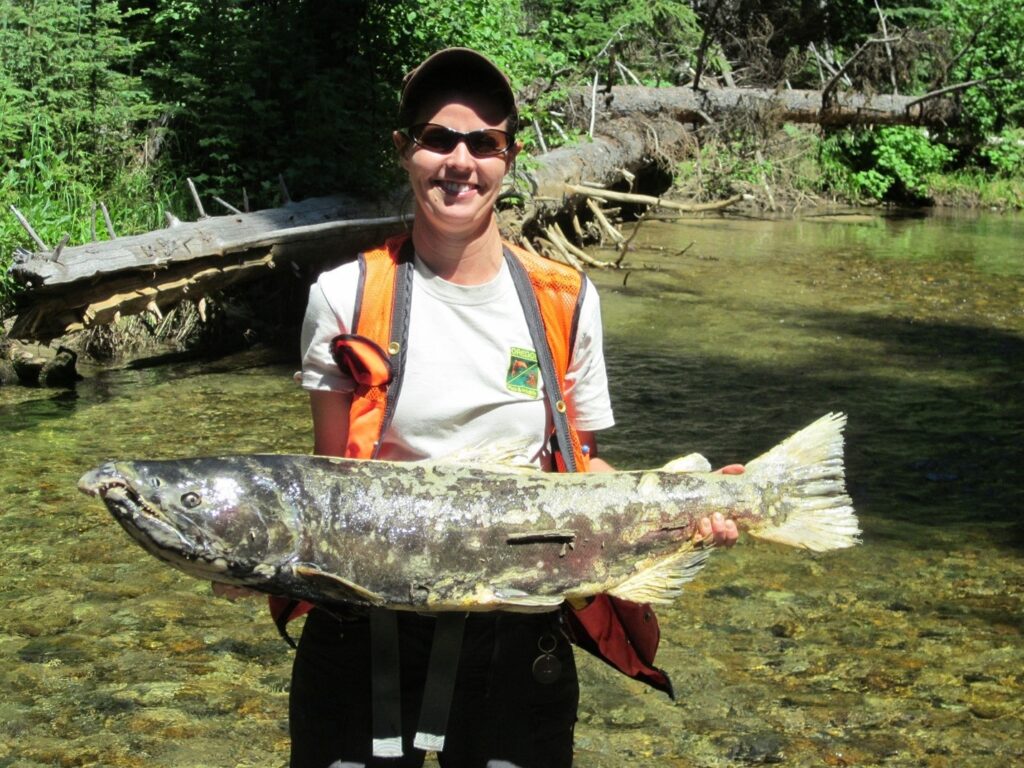
A LONG-RUNNING SALMON RESEARCH PROGRAM
Every spring, Oregon Department of Fish & Wildlife (ODFW) biologists survey the out-migration of juvenile spring Chinook salmon in the John Day River. This monitoring effort initially ran for 6 years in the 1970-80s, when the John Day Salmon Project first endeavored to quantify the basin’s spring chinook runs, and then resumed from 1998 to present.
With no dams or hatcheries to serve as fish-counting stations in the watershed, ODFW’s research and monitoring program is responsible for determining abundance of fish populations relative to escapement targets established for recreational fisheries each year. That monitoring takes place in different portions of the watershed seasonally. In the spring, biologists count and PIT-tag out-migrating juvenile salmon (i.e., “smolts”), then keep track of the tagged fish as they pass through the federal dams downstream as juveniles, and back upstream as adults. In the fall, biologists survey spawning areas and count adult salmon.
There are two primary purposes for this effort. First, ODFW must establish an abundance estimate for each year’s cohort of spring Chinook that leave the basin as smolts, as well as the fish returning as adults. Second, ODFW quantifies on an annual basis the smolt-to-adult return ratio (SAR) for each cohort of John Day salmon. Simply put, ODFW biologists monitor how many juvenile salmon leave the basin each spring (the juvenile population estimate), how many individual fish return to the watershed as adults each year (the adult population estimate) and the age structure of those fish, and what percentage of juvenile fish from preceding years ultimately returned as adults (the SAR).
Ultimately, fish research on the John Day demonstrates trends in population sizes, survival of salmon through the federal hydropower system and Pacific Ocean, and whether populations can sustain recreational fisheries. Research also informs prioritization and adaptive management of restoration efforts in the basin because monitoring allows ODFW biologists to keep tabs on salmon distribution, survival, and productivity changes after habitat restoration.
(To learn more about fish research conducted in the John Day watershed, check out the papers “Length and Condition of Wild Chinook Salmon Smolts Influence Age at Maturity” (2015) (demonstrating that high salmon spawner abundances reduced smolt size which contributed to production of older and larger adult salmon) and “Smolt Transportation Influences Straying of Wild and Hatchery Snake River Steelhead into the John Day River” (2020) (demonstrating that barging of Snake River basin steelhead caused high “stray” rates of hatchery and wild steelhead into the John Day).)
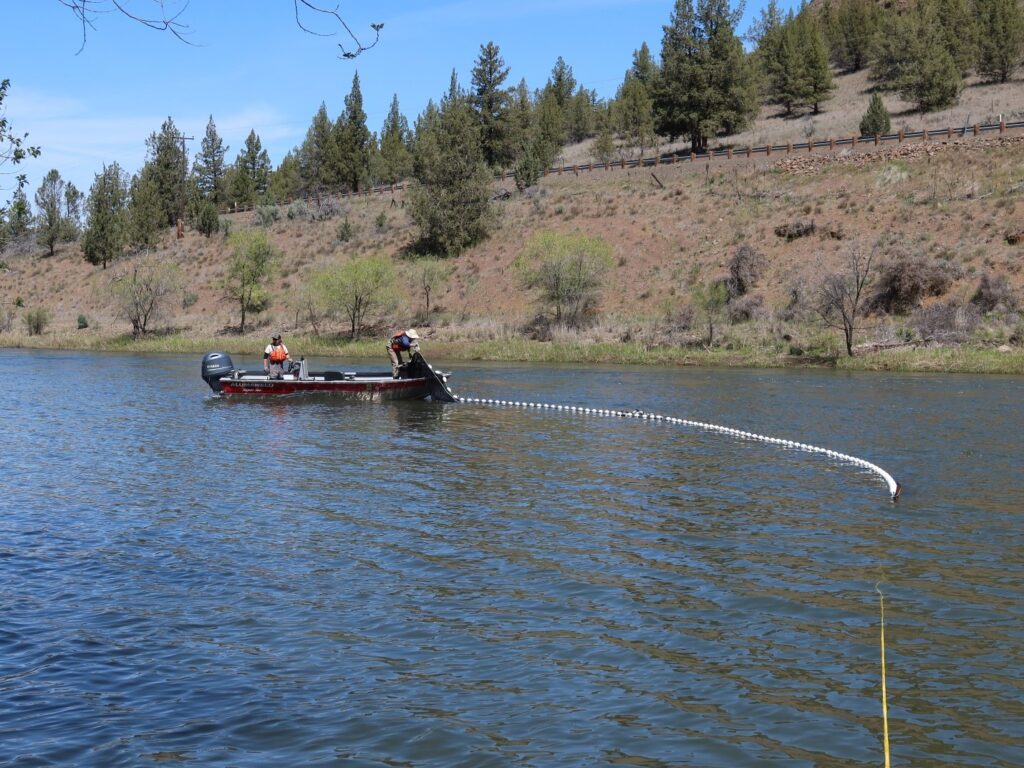
PULLING NETS: A DAY ON THE RIVER
In April, I had the opportunity to join ODFW for a day of monitoring juvenile Chinook smolt outmigration numbers in the John Day River near the town of Spray.
Ian Tattam (Fisheries Research Project Leader at ODFW) and Jeremy Henderson (Assistant Project Leader at ODFW) are responsible for the annual effort each spring and hosted the day’s volunteer effort. Our task was to launch a jetboat with a long seine net (basically a vertical curtain of netting with buoys on top and weights along the bottom) and deploy the net in slow water where smolts congregate.
The boat operator would drop one person ashore at the upstream end with a rope attached to one end of the net, back the boat out into the current while feeding out net, and then come back ashore with the other end of the net. Once all three people were ashore, the team pulled the net ends together and onto the bank, capturing anything within the curtain in a small remaining bathtub-size space in the water.
Over the course of the day, we seined seven different locations in approximately three hours. Given the long-running history of ODFW monitoring in this reach, each of the sampling locations had been sampled many times—and by a couple generations of state biologists.
At the end of the sampling, we transported all of the fish downstream to the boat launch to document and PIT-tag the day’s catch. Ian and Jeremy quickly measured, weighed, and PIT-tagged each fish (under anesthesia), then moved the smolts into a recovery tank.
Once recovered, Jeremy released the fish at the upstream end of the sampling reach as part of a mark-recapture study. By documenting the number of fish recaptured in subsequent sampling days, ODFW can calculate the overall estimated out-migrating smolt population size.
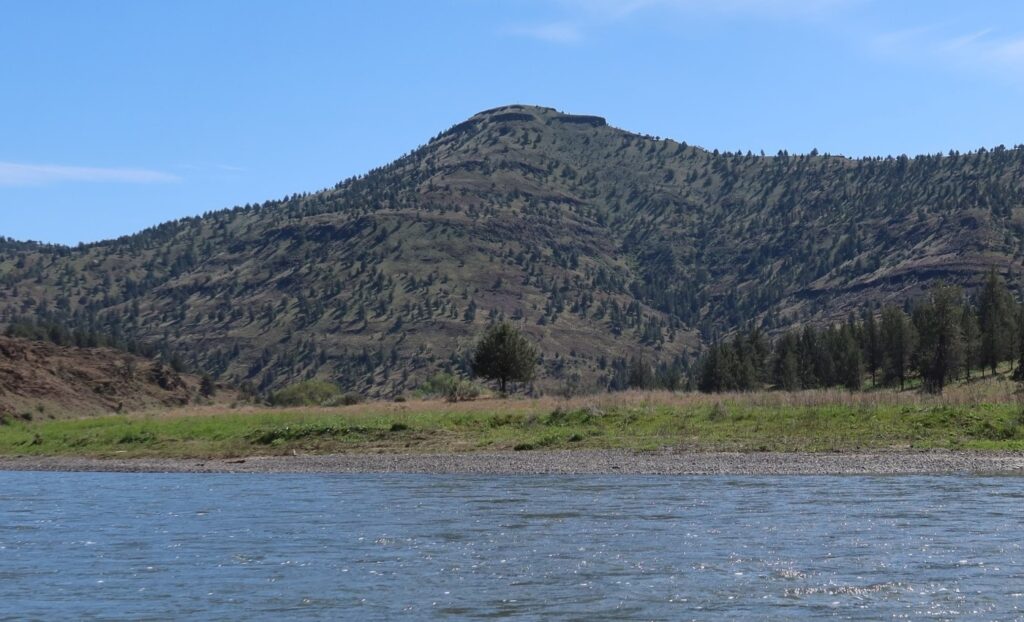
One of the many upsides to spending the day with an ODFW biologist in the field is the opportunity to hear about surprising observations of fish behavior. For instance, Jeremy Henderson reported that monitoring data on the John Day has shown at least one summer steelhead that traveled to the ocean and returned three times! Ian Tattam shared that he once PIT-tagged a spring Chinook smolt in Bridge Creek (the watershed where much of the early science on beaver dam analogues (BDAs) occurred), and then captured the same individual in nearly the same spot three years later after it had returned from the ocean. Remarkably, ODFW’s monitoring has demonstrated that after smolts are captured and released in the ODFW seine-netting activities, they can make it from the vicinity of Spray (about 170 miles upstream of the Columbia), down through Bonneville Dam and into the lower Columbia River in the course of only one week!
Turning up fun facts about fish in the places we love isn’t the purpose of ODFW monitoring programs, but we may as well enjoy and learn from them!

THE PURPOSE AND IMPORTANCE OF MONITORING
So, what does the public get in return for all this effort and expense?
- Monitoring allows and sometimes creates recreational fishing opportunities. Many anglers suspect that monitoring and data collection by ODFW is used to restrict angling or close fisheries. Certainly, this is true in some instances; for example, during certain salmon seasons on the Columbia River, fish managers close the season after a quota of fish are harvested or ESA-listed stocks are impacted. However, in many recreational fisheries—and especially catch and release fisheries for wild steelhead—fisheries are only open because fish managers are keeping an eye on fish returns and opening seasons on those populations. Moreover, when monitoring shows large returns of fish that aren’t typically open to fishing, fish managers can and do open fishing or harvest opportunity on those stocks (such as the 2016 spring Chinook season on the John Day River). In the past several years, the John Day River has tacked between closed and open seasons for summer steelhead because adult return numbers did not always hit ODFW’s return goals. If we as anglers do not advocate for and support programs at ODFW to ensure monitoring continues in the field, then in periods of generally poor to fair fish returns, we run the risk of fish managers needing to take precautionary approaches to fish management that may include defaulting to “closed” fisheries.
- Monitoring often turns up the first signs of a problem for fish populations, while also informing prioritization and investments on restoration actions. When salmon or steelhead (juveniles or adults) don’t show up as expected, it’s often agency field staff such as monitoring folks that notice and allow the state to take steps towards addressing the concern or underlying problem. For example, smolt monitoring data for the Middle Fork John Day River predicted a very low adult spring Chinook return in 2021. In response to the low run prediction ODFW was able to coordinate with habitat restoration staff from multiple agencies to change in-water stream habitat work and avoid any impact to that year’s small adult population.
- Results from prior and ongoing John Day basin monitoring efforts are one of the primary scientific underpinnings for the argument to breach the Lower Snake River dams. Trout Unlimited supports the effort to breach four dams on the lower Snake River to benefit salmon and steelhead. A self-replacing salmon or steelhead population has a 2% SAR, meaning that for every 100 smolts that out-migrate to the ocean, two adults make it back to spawn. In the Snake basin upstream of the Lower Four Snake dams, the Chinook SAR is 0.7% (signaling a population trending towards extirpation). Chinook salmon in the John Day basin face mostly the same estuary and ocean conditions—and three of the four same lower Columbia dams—as Snake River salmon, yet the SAR for Chinook in the John Day is sustainable at well over 2%. In fact, John Day Chinook SAR has been up to 11% in some years. Monitoring of SARs in the John Day River demonstrates that Lower Snake dams are the key limiting factor for healthy and abundant salmon and steelhead in the Snake watershed. (See this article to learn more about the science of SARs and how it differs for fish returning to the John Day versus rivers above the Lower Snake River dams.)
In summary, the purpose of ODFW’s fish monitoring program is not to count fish and file away the information in dusty notebooks. Rather, monitoring is an essential basis for supporting and allowing recreational fishing seasons to occur now and in the future.
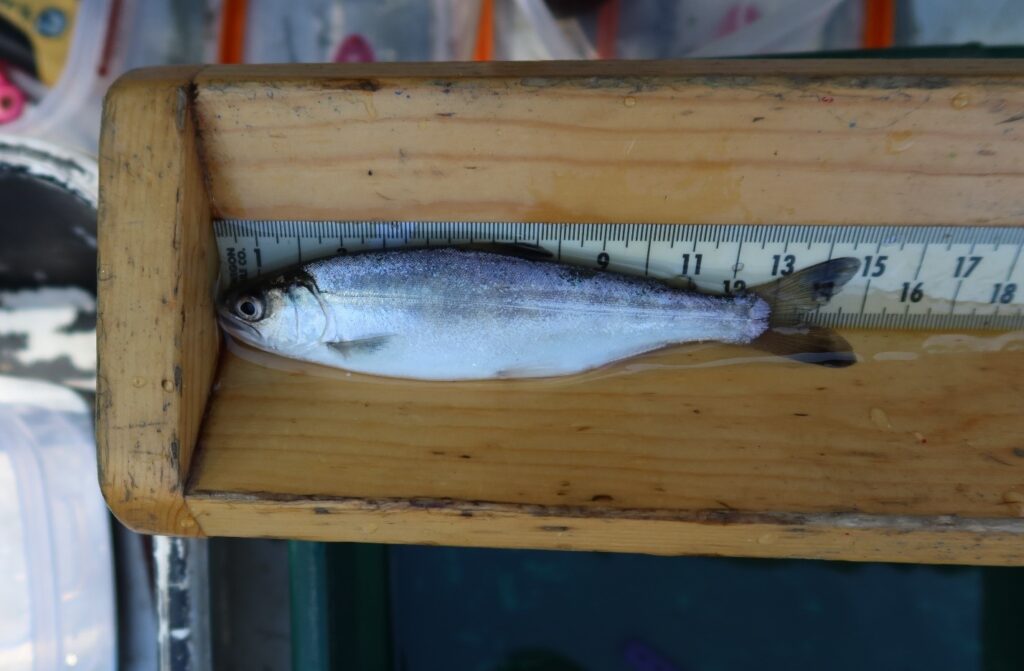
WHAT IS TU DOING TO SUPPORT ODFW MONITORING?
Wild Steelheaders United and Trout Unlimited consistently advocate in the Oregon Legislature for funding to support ODFW monitoring programs, and we will continue to do so in the 2025 legislative session (which will establish the 2025-2027 biennial budget for state agencies).
Fish monitoring and research in Oregon watersheds including the John Day is dependent upon sustained funding. For example, the State of Oregon funds ODFW efforts to monitor adult salmon populations via spawning surveys, but the federal government funds the juvenile salmon seine-netting activities as part of the Bonneville Power Administration’s fish and wildlife program. In current times of flat federal funding and widespread inflation, TU will advocate to protect and secure funding for ODFW programs that steward valued fisheries.
Last year, TU and Wild Steelheaders held a fundraiser to support the John Day Steelhead Project, to pay for an analysis of how tagged steelhead use, move through, and often miss, the John Day River’s mouth. We will continue to support science that investigates how and why approximately 80% of John Day steelhead pass up their natal river and end up about 70 miles upriver at McNary Dam—and how we can ameliorate negative effects of this “overshoot” issue.
Many thanks to ODFW for having us along, and a friendly reminder that monitoring plays a key role in allowing fisheries to occur, let alone restoring those stocks and the habitat the fish depend upon.
James Fraser is the Oregon Policy Director at Trout Unlimited (james.fraser@tu.org).


